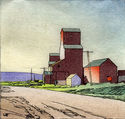
19th, 20th & 21st Century Fine Prints
707-546-7352 · fax 707-546-7924 · web: www.annexgalleries.com · email: artannex@aol.com
Walter Joseph Phillips Biography
Walter Joseph Phillips
Canadian
1884–1963
Biography
Walter Joseph Phillips was born at Barton-on-Humber, in Lincolnshire, England, on October 25, 1884. Walter was educated in various schools, and soon demonstrated an inclination for drawing. Enrolled at a boarding school at Quinton, near Birmingham, he won a scholarship in mathematics in 1898 which he spent on tuition at the Municipal School of Art in Birmingham. More instruction in art was received from the Municipal School of Art and Science in Great Yarmouth. In 1902, a visiting uncle who was working in South Africa suggested he visit.
Phillips lived in South Africa for about 5 years, returning to England in 1907. In 1908, Phillips obtained the position of Art Master at the Bishop's School in Salisbury. It was there that he met Gladys Pitcher, a student at the school, whom he later married in December of 1910. Phillips held two exhibitions in Salisbury in 1911 and 1912. By then, he and Gladys had decided to emigrate to Canada, and they chose Winnipeg, Manitoba, as their destination after consulting a map of Canada.
The Phillips’ arrived in Winnipeg in 1913. Walter met other artists then working in Winnipeg, such as Cyril Barraud, a fellow-Englishman who had arrived a year earlier, and was now engaged in etching. Phillips and Barraud held a joint exhibition in Winnipeg in October of 1914.
In 1915, Phillips decided to take up etching. As Barraud was leaving for England to enlist in the country's effort in the World War, Phillips was able to acquire Barraud's etching press and equipment. Phillips completed about thirty etchings within two years and his efforts were rewarded by a purchase by the National Gallery of Canada.
By 1917, Phillips was experimenting with a new printmaking medium, color woodcut. With the few references available to him in Winnipeg, Phillips nevertheless was able to produce color woodcuts, which increased in sophistication as his experience with the medium increased. His success with the color woodcut medium led him to abandon etching completely. His first show of woodcuts followed 1924. He wrote The Techniques of the Color Wood-Cut in 1926, and published The Canadian Scene, with seven color woodcut illustrations, Essay in Wood, containing ten woodengravings, and Winter Wood-Cuts, with fifteen color woodcuts. He also illustrated a variety of books with his woodcuts.
Phillips continued to live and teach in Winnipeg. His prints began to be noticed and he corresponded with artists in England who also worked in the medium. Phillips continued to exhibit and travel throughout the 1930’s.
He was invited to teach at the Banff Summer School in 1940. The following year, he was also invited to teach at the Provincial Institute of Technology and Art in Calgary. Walter and Gladys Phillips moved to Calgary in the fall of 1941. He was now 55 and the proximity to the mountains now allowed him to concentrate on the mountains as far as his subject matter was concerned. After the War, Phillips decided to build a home in Banff. His work as a watercolorist reached new heights at this time, although his activity as a printmaker diminished. He made no prints after 1952.
Walter Phillips died in Victoria, BC, Canada on July 5, 1963.
He was a member of the Print Makers Society of California, Graver Printers in Colour (London), the Society of Print-makers of Los Angeles, California, Boston Arts and Crafts Society, and Prairie Print Makers. Phillips received the Storrow Prize at the California Printmakers International Exhibition, Los Angles; the Bronze Medal for best color wood-cut from Graphic Arts, Toronto; and Gold Medal for best color wood-cut from the Society of Arts and Crafts, Boston.





